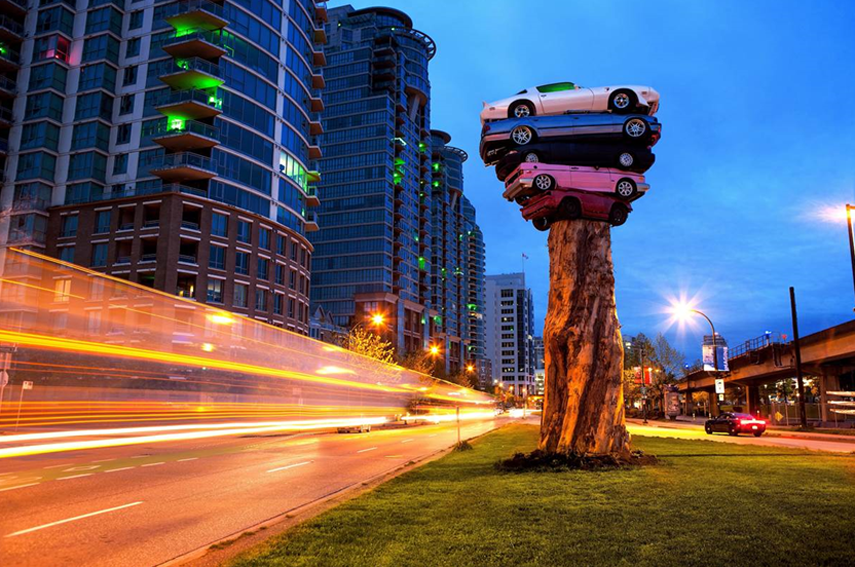“GM specification steel-belted radials, seven-inch rally tube wheels, heavy duty front and rear stabilizer bars, special high-effort power steering and power front disc brakes give Trans-Am precise, sports car handling.” – commercial for the 1977 Trans-Am
Burt Reynolds gunned the 6.6-litre engine of his Trans-Am, running Coors from Texarkana to Atlanta and leaving that durn sheriff looking like a possum’s pecker.
The 1970s were coming to an end when Smokey and the Bandit was released. Between the Clean Air Act and an oil crisis, it was a helluva time to be a muscle car.
But with Reynolds at the wheel of cinema’s greatest beer run sales accelerated at Pontiac. By 1979 Firebird production was at an all-time high with 117,108 Trans-Ams rolling off the assembly line, according to Hemmings.com.
But while new cars were speeding out of dealerships, Marcus Bowcott trained his painter’s eye on the old ones.
When he couldn’t get a full-time teaching contract, Bowcott found a job as a deckhand, working up and down the Fraser River and the Arctic, and watching waves lap up against the metal carapaces of used-up cars.
“I’d see these cars, just piles of them in wrecking yards, and they were literally spilling in the water.”
Sometimes farmers would even use the Manic GTs and Beaumont Cheetahs as breakwaters, Bowcott recalls.
Bowcott at first tried to capture it with oil on canvas at first, but it didn’t work.
“They were somehow too heavy,” he remembers.
He needed a new approach. Maybe some humour. Some stature.
Years later, working as Capilano University’s painting and drawing instructor, he found himself inside the sculpture studio, making maquettes of piled-up cars that could fit on your coffee table.
He put them on columns and soon he was referencing ancient statuary and classical architecture.
“Just playing around,” he remembers. “And also kind of mimicking advertising in an absurd way.”
“Its family name: Firebird. An Indian symbol that promises youth, beauty, and strength.”
– commercial for the 1977 Trans-Am
With the Vancouver Biennale interested and the Canada Council for the Arts offering a grant, the Vancouver artist decided it was finally time for his totem.
After scooping the Oldsmobile-sourced 403-cubic inch V-8s and the Rochester Quadrajet four-barrel carburetors out of the chassis, he welded five hollowed sports cars welded together atop an old-growth cedar.
It wouldn’t have been possible without partner and collaborator Helene Aspinall as well as engineer Eric Karsh, who worked for the piece of the price of the painting.
“I’ve been around a lot of years showing my work,” he says. “I’ve never been high-fived for a piece … until Trans Am Totem.”
“It’s beginning to become a bit of a landmark,” Aspinall explains.
The site borders Squamish village Senakw. That history is represented by a bear paw carved into the cedar by Rick Harry (Xwalacktun).
“The piece is about the site. It’s about the old-growth forest, it’s about the Squamish living in this area, on this land,” Bowcott says.
“The site really holds this piece,” Aspinall agrees, noting its position as a spiral amid skyscrapers, SkyTrains, and viaducts.
The work has resonated across continents, as Bowcott and Aspinall were recently asked to bring their work to Munich, Germany.
“They found him over the Internet,” Aspinall laughs.
After the notion of transporting 25,000 pounds of steel and wood cedar was deemed too expensive, the duo elected to erect a new, similar piece titled: An Apparatus for Divining Capital.
The word capital refers to architecture, sculpture, or money, Bowcott says. Divining refers to a search for water.
Without any huge trees available, the plan is to flip a willow tree upside down and stack a chopped Mercedes followed by a Volkswagen, Audi, and “on the very top” a 7-series BMW. The placement is hilarious, says Bowcott, noting the totem will be a stone’s throw from a BMW museum.
Bowcott explored the idea of putting an Austin Mini on the bottom, “because it’s small and British,” but ultimately disliked the optics.
“We don’t want to get into one country being on top of another country.”
A month before they’re set to head into Germany, Bowcott and Aspinall are busy fixing the solar lights on the Trans Am Totem, giving it a green glow reminiscent of Emilio Estevez’s Chevy Malibu in Repo Man.
While there’s “mixed feelings” on the totem among residents, the green lights are meant to stand in solidarity with neighbours calling for a new park.
In some ways, the sculpture is a towering dilemma.
Aspinall points out that the Trans -Ams are from 1979, back when drivers weren’t “really paying that much attention to environmental concerns.”
But Bowcott says there’s a “love of automobiles” embedded in the work as well, calling the cars: “beautifully designed objects.”
It still is a helluva time to be a muscle car.



